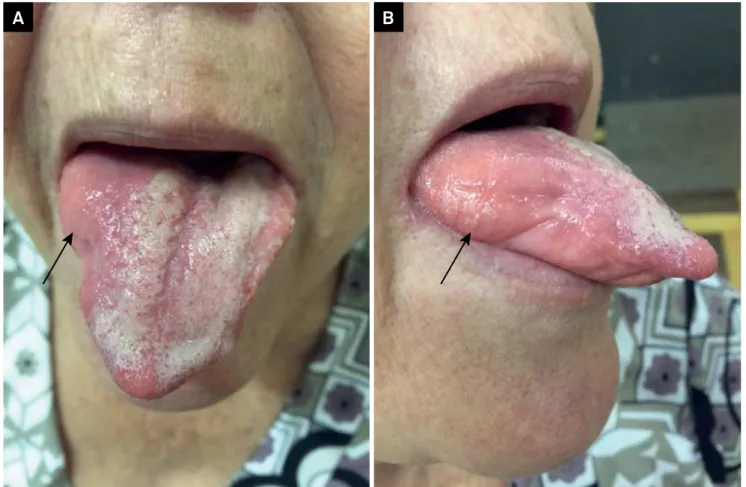835
https://doi.org/10.1590/0004-282X20170130
IMAGES IN NEUROLOGY
Abnormal tongue features as a clinical clue for
late-onset Pompe’s disease
Achado anormal na língua como dica clínica para doença de Pompe de início tardio
Wladimir Bocca Vieira de Rezende Pinto
1, Paulo Victor Sgobbi de Souza
1, Thiago Bortholin
1, Fernando
George Monteiro Naylor
1, Acary Souza Bulle Oliveira
1A 58-year-old woman presented with slowly-progressive
lower limb weakness. Medical history disclosed a six-year
his-tory of obstructive sleep apnea syndrome (OSAS). Examination
disclosed abnormal tongue features (Figure 1) and proximal
laccid tetraparesis. Muscle MRI showed marked compromise
of the adductor magnus, and muscle biopsy disclosed
vacu-olar myopathy with PAS-positive vacuoles (Figure 2). Dried
blood spot-based GAA (acid alpha-glucosidase) activity
test-ing and
GAA
gene sequencing conirmed late-onset Pompe’s
disease (LOPD). Clinicians should consider LOPD in cases of
limb-girdle weakness with atypical indings
1, such as
obstruc-tive sleep apnea syndrome, pulmonary hypertension, axial
involvement with myotonic or complex repetitive discharges
and tongue weakness with fatty iniltration
2.
1Universidade Federal de São Paulo, Departamento de Neurologia e Neurocirurgia, Divisão de Doenças Neuromuscular, São Paulo SP, Brasil.
Correspondence: Wladimir Bocca Vieira de Rezende Pinto; Departamento de Neurologia e Neurocirurgia da UNIFESP; Rua Estado de Israel, 899; 04022-002 São Paulo SP, Brasil; E-mail: wladimirbvrpinto@gmail.com
Conflict of interest: There is no conflict of interest to declare. Received 17 December 2016; Accepted 17 July 2017.
A
B
836
Arq Neuropsiquiatr 2017;75(11):835-836References
1. Hagemans ML, Winkel LP, Van Doorn PA, Hop WJ, Loonen MC, Reuser AJ et al. Clinical manifestation and natural course of late-onset Pompe’s disease in 54 Dutch patients. Brain. 2005;128(3):671-7. https://doi.org/10.1093/brain/awh384
2. Milisenda JC, Pujol T, Grau JM. Not only bright tongue sign in Pompe disease. Neurology. 2016;87(15):1629-30.
https://doi.org/10.1212/WNL.0000000000003211

